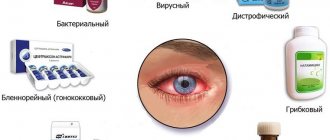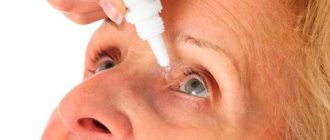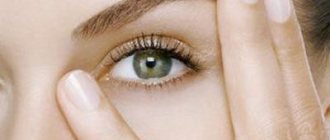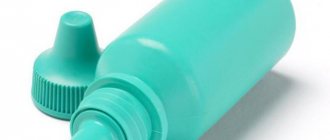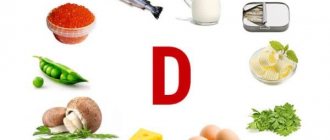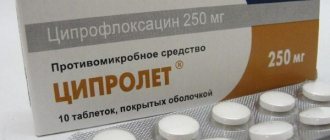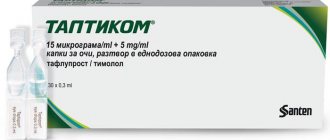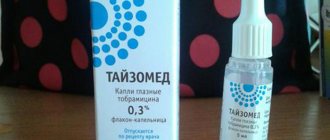What to choose: Taufon or Taurine?
For many pathologies of the retina and cornea, doctors prescribe medications that have natural restorative functions, such as Taufon or Taurine. Those who suffer from similar diseases need to get acquainted with their characteristics.
For many pathologies of the retina and cornea, doctors prescribe medications that have natural restorative functions, such as Taufon or Taurine.
Recommended analogues
Taufon has analogues that are not inferior in therapeutic results, but at a higher cost.
Catalin
The medicine is presented in the form of tablets that must be dissolved in a special liquid. Catalin is produced in Japan. Prescribed for therapy for cataracts.
You can purchase the medicine only with a prescription. Catalin is also suitable for long-term treatment. The cost is about 480 rubles.
Oftan Katahrom
The drug is used in the treatment of cataracts; it can be used for prophylactic purposes.
Suitable for long-term use. Oftan-Katachrome relieves inflammatory reactions and acts as an antioxidant. On average, the cost of the drug is 300 rubles.
Ophtolic
The product is produced in India. Oftolik is used to moisturize the mucous membrane of the eyes. The medicine protects the cornea of the eye and eliminates dryness. The active ingredient is polyvinyl alcohol. The auxiliary component is povidion.
The medication is used for fungal infections, colds and inflammatory reactions. Oftolik protects the conjunctiva and cornea during erosive processes or trauma. Costs about 300 rubles.
Quinax
The medication is included in therapy during the initial course of cataracts.
Side effects of Quinax therapy include pain, lacrimation or hyperemia. The price range ranges from 396 rubles.
Similar drugs to Taufon may have a less pronounced therapeutic result, so a doctor must determine a substitute.
Author's rating
Author of the article
Alexandrova O.M.
Articles written
2031
about the author
Was the article helpful?
Rate the material on a five-point scale!
( 4 ratings, average: 4.25 out of 5)
If you have any questions or want to share your opinion or experience, write a comment below.
Characteristics of Taufon
The drug Taufon is available in the form of eye drops. They contain the active substance taurine and the auxiliary component water for injection. The drops are bottled in 5 and 10 ml bottles.
Taufon has several beneficial effects:
- restores cells damaged by various unfavorable factors at the molecular level;
- protects the retina from the negative effects of the environment;
- improves oxygen supply to eye tissues;
- regenerates eye tissue.
Ophthalmologists recommend using drops for the following diseases:
- Conjunctivitis. This pathology causes damage to the membrane that envelops the eye. The disease is characterized by the development of inflammation. Taufon relieves swelling, eliminates pain, and eliminates bleeding. In case of severe pathology, drops are used in conjunction with other medications.
- Barley. Drops help eliminate inflammation of the hair follicle of the eyelashes, normalize local blood circulation, reduce discomfort, and increase visual acuity.
- Cataract. The medicine helps the body stop the development of pathology, preventing surgical treatment.
- Glaucoma. The drug prevents the progression of pathology and reduces symptoms. With such a dangerous disease, drops should be used with caution.
- Eye pressure. Taufon promotes better outflow of intraocular fluid, preventing the development of the disease. Drops improve local metabolic processes and normalize intraocular pressure.
- Dystrophy of the ocular cornea. By helping to strengthen blood vessels and improve metabolism at the local level, the drops improve the condition of the retina.
- Corneal injury. The medicine restores damaged tissue caused by microtrauma.
Ophthalmologists recommend using Taufon for conjunctivitis.
Taufon is recommended to be used to prevent fatigue and swelling of the eyes, and blurred vision.
Drops are not recommended for use during pregnancy and breastfeeding, as well as for those whose bodies are intolerant to the substances included in the drug.
Long-term use may result in the appearance of negative symptoms - nasal congestion, dry cough, tearing, redness of the eyelids.
Compound
First, let’s look at the website for the treatment of eye diseases in Moscow and find there the characteristics of the structure of each of the preparations:
- The main active substance in Taurine and Taufon drops is the same - the amino acid taurine, which has a concentration of 40 mg per ml of the finished medication
- Auxiliary components: purified water and nipagin.
As you can see, the compositions do not differ and both are sterile. If there are no differences in the components from the word “at all,” then why is Taufon, in the pharmacist’s opinion, more effective?
The manufacturing company that produces Taufon eye drops comments on such a high cost as follows: the raw materials necessary for the production of the medicine are of the highest quality, which is significantly different from Taurine. This fact raises some doubts. The thing is that in most cases similar medications are produced by the same company, how then can you sort the raw materials into categories?
Action of Taurine
The active ingredient of the drug is taurine, which is a beneficial sulfonic acid. Release form: eye drops. Sulfonic acid is produced in the body and has several actions, including participation in the metabolic processes of cells and tissues. With age, the body produces less and less of this beneficial substance, so it is necessary to take it additionally.
Taurine in the form of eye drops is indicated:
- for dystrophy, keratitis and retinal erosion;
- with ophthalmoherpes;
- for glaucoma (but only as part of complex therapy);
- for diseases of the retina;
- in case of disorders of the optic nerve;
- for cataracts;
- as a preventative measure to protect the eyes from the adverse effects of the environment, including for people who spend a lot of time in front of a computer monitor.
Taurine is contraindicated in case of individual intolerance to the components included in the drops. Doctors do not recommend using the drug during pregnancy and breastfeeding, as well as for children and adolescents under 18 years of age.
During therapy, side effects sometimes develop in the form of redness of the eyeball, itching and burning. In this case, you must stop using the drops and consult a doctor.
Taurine is contraindicated in case of individual intolerance to the components included in the drops.
Artificial tears for hydration in myopia
Systane
Systane is used to moisturize the eyes for myopia. The drug eliminates the symptoms of irritation and dryness that occur when the visual system is overstrained. Systane contains polydronium chloride, calcium chloride, zinc chloride, sodium chloride, boric acid and polyethylene glycol.
The effect of using the drops lasts throughout the day. Systane protects the eyes from exposure to smoke, dust, dry air, sun, chlorinated water and other irritants. The product can be used to eliminate dryness when wearing contact lenses. You need to instill 1-2 drops several times a day (depending on symptoms).
Oksial
The product contains hyaluronic acid and electrolytes, which effectively moisturizes the mucous membrane of the eye and relieves symptoms of irritation. The film created by Oksial on the mucous membrane of the eye protects against external irritants. The drug can be prescribed for increased visual stress and dry eye syndrome.
Oxial is recommended to be instilled as needed. You don't have to remove your contact lenses. When using Oksial, side effects are possible: redness, blurred vision, itching.
Vidisik
The main component of the drug is carbomer. Vidisik is prescribed for insufficient secretion of tear fluid and keratoconjunctivitis sicca.
Vidisik for myopia is prescribed three times a day. After instillation, short-term blurred vision is possible. Long-term use increases the risk of eye irritation.
What are the differences and similarities between Taufon and Taurine?
The active ingredient of both drugs is the same substance - taurine. Medicines are prescribed for the same diseases and have similar contraindications and side effects. Both drugs can be purchased at pharmacies without a doctor's prescription. Medicines are produced in Russia.
The difference between the drugs lies in the additional substances. Taufon includes expensive nipagin, which promotes faster tissue restoration. Taurine contains methyl parahydroxybenzoate, which does not provide the same therapeutic effect for glaucoma and cataracts as nipagin. Hospitals prefer to use Taufon.
Are there any differences in methods of application, dosages?
Despite the fact that the indications for the use of Taufon in some instructions indicate that the medicine helps with open-angle glaucoma, there is not a word in the methods of use about the dosage for this disease. Both drugs with identical composition are used in the same way:
- 3 or 4 instillation procedures per day, 1 or 2 drops.
- In cases of corneal lesions, the duration of treatment is 1 month.
- For initial stage cataracts – 3 months.
- How many months and drops there are for glaucoma, there is not a word about this in the Taufon instructions.
That is, the same composition and similar treatment methods indicate the identical effects of these two medicinal ophthalmic solutions.
Is there a difference in limiting use?
Contraindications for eye medications Taufon and Taurine are also similar:
- Use without a doctor's prescription is not recommended.
- Individual intolerance to the amino acid taurine.
- Age restriction: not allowed under 18 years of age.
- Use caution during pregnancy.
- Even the restrictions on the period of use of eye drops are the same: store a sealed bottle for no more than 3 years, and an open bottle for up to a month.
Attention! You cannot self-medicate. Instead of improving the nutrition of eye tissue, you can get swelling of the mucous membranes, clouding of the corneal tissue and other dangerous consequences! The use of Taufon drops, as well as Taurine, is permitted only after examination by an ophthalmologist in the dosage indicated by him.
About doctors' reviews
Practicing ophthalmologists issue prescriptions based on the availability of drugs in pharmacies in the city and village. Each regional Ministry of Health publishes the availability of medicines on its website. And at meetings, doctors are told about supplies and purchases. If sales do not include an inexpensive analogue, the doctor may prescribe the expensive Taufon rather than the cheap Taurine. Reviews are equally good about both drugs.
Description of the eye product
Any analogue of Taufon and the presented drug itself are special anti-cataract eye drops that have a metabolic and retinoprotective (only when administered subconjunctivally) effect.
As mentioned above, the active component of this product is taurine. It is a sulfur-containing amino acid that is converted to cysteine in the human body. This drug is capable of stimulating the processes of regeneration and repair for dystrophic disorders and diseases accompanied by a sharp metabolic disorder of eye tissue.
Almost every analogue of “Taufon” and the named medication itself activates energy and metabolic processes, normalizes the functioning of cell membranes, and also preserves the electrolyte composition of the cytoplasm, thanks to the accumulation of calcium and potassium, and significantly improves the conditions for the conduction of nerve impulses.
